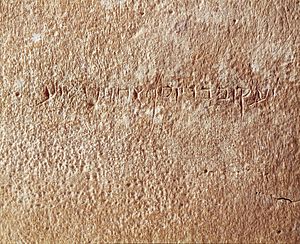James Ossuary
An Aramaic inscription meaning "Jacob (James), son of Joseph, brother of Yeshua" is cut into one side of the box.
[1] The existence of the ossuary was announced at an October 21, 2002, Washington press conference co-hosted by the Discovery Channel and the Biblical Archaeology Society.
[6] However, in an external expert report, dated September 2005, Wolfgang E. Krumbein's conclusions contradicted those of the IAA, stating: "Our preliminary investigations cannot prove the authenticity of the three objects beyond any doubt.
The opening was to coincide with meetings of scholarly groups such as the Society of Biblical Literature and American Academy of Religion that were to take place in the city in November.
The first-century origin of the ossuary is not in question, since the only time Jews buried in that fashion was from approximately 20 BC to the destruction of Jerusalem in 70 AD.
[19][page needed] On June 18, 2003, the Israeli Antiquities Authority published a report, based on their analysis of the patina, which concluded that the inscription is a modern forgery.
[20] He further noted in his report, "any forgery of three very distinct types of patina, if ever possible, requires the development of ultra-advanced techniques, in-depth knowledge and extensive collaboration of a large number of experts from various fields".
[21] In 2004, an analysis of the ossuary's petrography and oxygen isotopic composition was conducted by Avner Ayalon, Miryam Bar-Matthews and Yuval Goren.
"[24][25] In 2013, an archaeometric analysis by Amnon Rosenfeld, Howard Randall Feldman and Wolfgang Elisabeth Krumbein strengthened the authenticity contention of the ossuary.
"[27] Edward John Keall, the Senior Curator at the Royal Ontario Museum (ROM), Near Eastern & Asian Civilizations Department, continues to argue for the ossuary's authenticity, saying "the ROM has always been open to questioning the ossuary's authenticity, but so far no definitive proof of forgery has yet been presented, in spite of the current claims being made.
In articles in the February 2005 issues, several paleographic experts argue that the James Ossuary is authentic and should be examined by specialists outside of Israel.
"[30] The Israel Antiquities Authority wants to limit the trade in Bible-era artifacts, which they believe encourages grave robbers, who smuggle the choicest finds out of the country.
Golan was indicted in an Israeli court along with his three co-defendants: Robert Deutsch, an epigraphy expert who has given lectures at the University of Haifa; collector Shlomo Cohen; and antiquities dealer Faiz al-Amaleh.
They were accused of manufacturing numerous artifacts, including an Ivory pomegranate which had previously been generally accepted as the only proven relic from the Temple of King Solomon.
Later under oath, the government's chief scientific witness, Professor Yuval Goren of Tel Aviv University admitted on cross-examination that there was original ancient patina in the word "Jesus.
"[13] Two paleographers, André Lemaire of the Sorbonne and Ada Yardeni of the Hebrew University of Jerusalem, pronounced it as authentic in the trial.
[13] In fact, Yardeni, who is considered an expert in the field, testified that the inscription is no doubt of ancient origin inscribed by a single individual, and stated, "If this is a forgery, I quit.
Judge Aharon Farkash, who has a degree in archaeology, indicated difficulty in making a judgment regarding the objects' authenticity if the professors could not agree amongst themselves.
[34] On March 14, 2012, Farkash stated "that there is no evidence that any of the major artifacts were forged [by Golan], and the prosecution failed to prove their accusations beyond a reasonable doubt".
From his view as a historian specializing in the social history of earliest Christianity, he found it "amazing how evidence falls into place when you begin with the conclusion—and a hammer.
"[39] When interviewed about the upcoming documentary, Amos Kloner, who oversaw the original archaeological dig of this tomb in 1980 said: Newsweek reported that the archaeologist who personally numbered the ossuaries dismissed any potential connection: Pfann also thinks the inscription read as "Jesus" has been misread and suggests that the name "Hanun" might be a more accurate rendering.
[42] The Washington Post reported that William G. Dever (mentioned above as excavating ancient sites in Israel for 50 years) offered the following: Ben Witherington III of Asbury Theological Seminary pointed out some other circumstantial problems with linking this tomb to Jesus' family:[44]
"[45]Lawrence E. Stager, the Dorot professor of archaeology of Israel at Harvard, said the documentary was "exploiting the whole trend that caught on with The Da Vinci Code.

